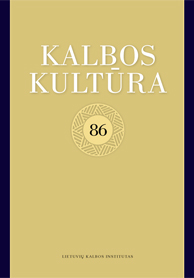Nauji duomenys apie įvardžių dviskaitą dabartinėje lietuvių kalboje
New Data about the Dual Number of Pronouns in Modern Lithuanian
Author(s): Deimantė KrikštaponytėSubject(s): Baltic Languages
Published by: Lietuvių Kalbos Institutas
Keywords: dual number of pronouns; principal and secondary variants;new forms;more frequent use;
Summary/Abstract: The article New Data about the Dual Number of Pronouns in Modern Lithuanian provides the forms of the dual number of pronouns whose inventory was made on the basis of the data kept in the Corpus of Vytautas Magnus University. However, it should be noted that the forms of the dual number of pronouns were first sought in the Grammar of Modern Lithuanian, Volume I of the Grammar of Lithuanian and A. Valeckienė’s Functional Grammar of the Lithuanian Language.The article addresses the problem of identification of coincident forms of masculine and feminine gender and discusses specific examples. Based on Language Recommendations, principal and secondary variants of the norm are singled out. Statistical data prompt a conclusion that the secondary variants of the dual number of masculine pronouns in the nominative case are more commonly used than the principal variants; however, the secondary variants of the dual numberof pronouns in the genitive case are far less commonly used than the principal ones. For example, the forms of the principal variants of the norm of the dual number of feminine pronouns used in both the nominative and the accusative case are far more common than the forms of secondary variants. What is more, the principal variants of the norm in the dative and instrumental case are far more common than secondary variants. The article further presents and discusses the forms of the dual number of pronouns, which do not belong to the first or the second paradigm and are most likely formed on the basis of equivalent forms of the said paradigms. The article ends with the comparison of statistics of the masculine variants in the nominative case of 2006 and 2013 leading to the conclusion that the forms of the dual number of pronouns in the Corpus of Vytautas Magnus University are on the increase. Of course, it is associated with the growth of the corpus itself; however, it is obvious that as the corpus is growing, the number of the forms of the dual number of pronouns tends to increase rather than decrease.
Journal: Bendrinė kalba (iki 2014 metų – Kalbos kultūra)
- Issue Year: 2013
- Issue No: 86
- Page Range: 179-191
- Page Count: 13
- Language: Lithuanian

